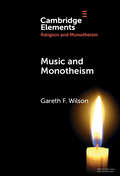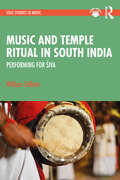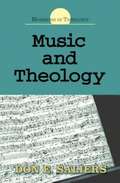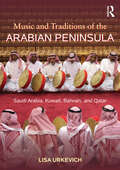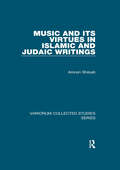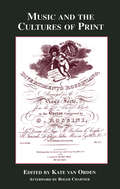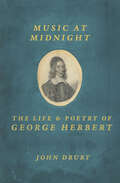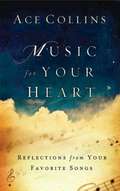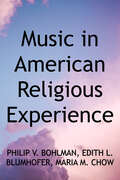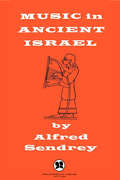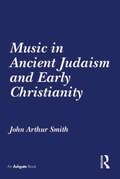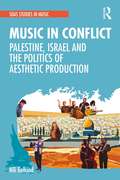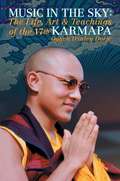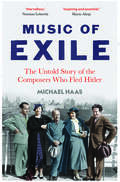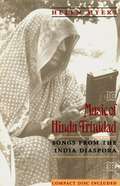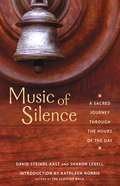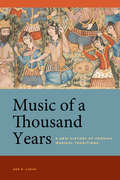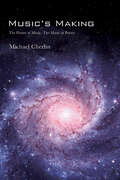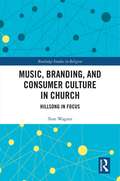- Table View
- List View
Music and Jewish Culture in Early Modern Italy: New Perspectives (Music and the Early Modern Imagination)
by Lynette Bowring, Rebecca Cypess and Liza MalamutMusical culture in Jewish communities in early modern Italy was much more diverse than researchers originally thought. An interdisciplinary reassessment, Music and Jewish Culture in Early Modern Italy evaluates the social, cultural, political, economic, and religious circumstances that shaped this community, especially in light of the need to recognize individual experiences within minority populations. Contributors draw from rich materials, topics, and approaches as they explore the inherently diverse understandings of music in daily life, the many ways that Jewish communities conceived of music, and the reception of and responses to Jewish musical culture. Highlighting the multifaceted experience of music within Jewish communities, Music and Jewish Culture in Early Modern Italy sheds new light on the place of music in complex, previously misunderstood environments.
Music and Mantras: The Yoga of Mindful Singing for Health, Happiness, Peace & Prosperity
by Girish&“Singing is as human as breathing, and this book tells us why.&” —Mark Guarino, contributing music writer, The Guardian Celebrated yogi-musician Girish opens new possibilities for transforming your life through song, combining the ancient art of singing mantra with twenty-first century neuroscience research.For as long as he can remember, Girish has created rhythm to accompany life. His first experience of music as sacred art came in college, playing with jazz bands. “During improvisational sessions,” he recalls, “there were these unexplainable moments of synchronicity and intuition that felt like magic.” This led Girish to an unexpected journey—a seeming detour to live as a monk in an ashram for five years that inadvertently nourished his musical artistry. Here, he studied Sanskrit as a means to understand the deeper meanings of ancient chants, which sparked a life-changing event that led him back to music—and to combine music with Sanskrit chants. Now he shares what he’s learned to help people of all ages, backgrounds, and traditions to transform body, brain, and life through mantra and music. With Music and Mantras, Girish has created an interactive toolkit—including more than ninety minutes of companion audio material—for personal transformation through singing, sharing his own experience as a musician, yogi, and former Hindu monk. Weaving simple, elegant mantras from ancient traditions with neuroscience, Girish shows us how to achieve greater peace of mind, clarity, calm, focus, and even improved health and wealth through the yogic art of chanting—an ideal practice for singing our way to happiness, health, and prosperity.
Music and Monotheism (Elements in Religion and Monotheism)
by Gareth F. WilsonWhat connects the phenomenon of music as an art with the belief in one indivisible God? What has music, a non-linguistic medium, to say about the personal, loving, communicative God of Scripture and the Prophets, or the omniscient, omnipotent, omnipresent, transcendent God of the Philosophers and can it bring these 'concepts of God' together? To answer these questions, this book takes divine Creation as its starting point, that the God of monotheism must be the Creator of all that is. It thus argues that anything which instantiates and facilitates communication within the created realm has been enabled to do so by a God who communicates with His Creation, and who wishes that His Creation be communicative. Indeed, it will argue that the communication allowed by music, and aesthetic experience in general, is the very raison d'être of Abrahamic monotheism and might thus allow an opportunity for dialogue between monotheistic faiths.
Music and Temple Ritual in South India: Performing for Śiva (SOAS Studies in Music)
by William TallotteMusic and Temple Ritual in South India: Performing for Śiva documents the musical practices of the periya mēḷam, a South Indian instrumental ensemble of professional musicians who perform during the rituals and festivals of high-caste (Brahmanical) Tamil Hindu temples dedicated to the Pan-Indian god Śiva – an important patron of music since at least the tenth century. It explores the ways in which music and ritual are mutually constitutive, illuminating the cultural logics whereby performing and listening are integral to the kinetic, sensory and affective experiences that enable, shape and stimulate ritual communication in present-day devotional Hinduism. More than a rich and vivid ethnographic description of a local tradition, the book also develops a comprehensive and original analytical model, in which music is understood as both a situated and creative activity, and where the fluid relationship between humans and non-humans, in this case divine beings, is truly taken into consideration.
Music and Theology (Horizons in Theology)
by Don E. SaliersMusic and Theology will be a volume in the Horizons in Theology series. It will offer a relatively brief but highly engaging essay on the major concerns and questions regarding Music as it intersects with theology—past and present. Don Saliers is a senior scholar in this field, one who is able to address in a clear and concise style the scope and contours of this question as it relates to theological inquiry and application. He will sketch the nature and significance of the subject, the history of reflection, the current lines of inquiry, and his own contribution to the discussion. The scope of the essays cannot be exhaustive and completely interdisciplinary. Instead, Saliers will open the broader lines of discussion in suggestive, evocative, and programmatic ways. The Horizons in Theology serve as supplements and secondary required texts in colleges and seminaries, as well as the interested nonspecialist reader.
Music and Theology in Nineteenth-Century Britain (Music in Nineteenth-Century Britain)
by Martin V. ClarkeThe interrelationship of music and theology is a burgeoning area of scholarship in which conceptual issues have been explored by musicologists and theologians including Jeremy Begbie, Quentin Faulkner and Jon Michael Spencer. Their important work has opened up opportunities for focussed, critical studies of the ways in which music and theology can be seen to interact in specific repertoires, genres, and institutions as well as the work of particular composers, religious leaders and scholars. This collection of essays explores such areas in relation to the religious, musical and social history of nineteenth-century Britain. The book does not simply present a history of sacred music of the period, but examines the role of music in the diverse religious life of a century that encompassed the Oxford Movement, Catholic Emancipation, religious revivals involving many different denominations, the production of several landmark hymnals and greater legal recognition for religions other than Christianity. The book therefore provides a valuable guide to the music of this complex historical period.
Music and Traditions of the Arabian Peninsula: Saudi Arabia, Kuwait, Bahrain, and Qatar
by Lisa UrkevichMusic and Traditions of the Arabian Peninsula provides a pioneering overview of folk and traditional urban music, along with dance and rituals, of Saudi Arabia and the Upper Gulf States of Kuwait, Bahrain, and Qatar. The nineteen chapters introduce variegated regions and subcultures and their rich and dynamic musical arts, many of which heretofore have been unknown beyond local communities. The book contains insightful descriptions of genres, instruments, poetry, and performance practices of the desert heartland (Najd), the Arabian/Persian Gulf shores, the great western cities including Makkah and Medinah, the southwestern mountains, and the hot Red Sea coast. Musical customs of distinctive groups such as Bedouin, seafarers, and regional women are explored. The book is packaged with an audio CD and almost 200 images including a full color photo essay, numerous music transcriptions, a glossary with over 400 specialized terms, and original Arabic script alongside key words to assist with further research. This book provides a much-needed introduction and organizational structure for the diverse and complex musical arts of the region.
Music and Transcendence
by Ferdia J. Stone-DavisMusic and Transcendence explores the ways in which music relates to transcendence by bringing together the disciplines of musicology, philosophy and theology, thereby uncovering congruencies between them that have often been obscured. Music has the capacity to take one outside of oneself and place one in relation to that which is ’other’. <P><P> This ’other’ can be conceived in an ’absolute’ sense, insofar as music can be thought to place the self in relation to a divine ’other’ beyond the human frame of existence. However, the ’other’ can equally well be conceived in an ’immanent’ (or secular) sense, as music is a human activity that relates to other cultural practices. Music here places the self in relation to other people and to the world more generally, shaping how the world is understood, without any reference to a God or gods. The book examines how music has not only played a significant role in many philosophical and theological accounts of the nature of existence and the self, but also provides a valuable resource for the creation of meaning on a day-to-day basis.
Music and its Virtues in Islamic and Judaic Writings (Variorum Collected Studies #875)
by Amnon ShiloahA fascinating aspect of the study of music in medieval Islamic and Judaic writings is the broad and interdisciplinary nature of the works and treatises in which it is covered. In addition, such works verbalize an art that was transmitted orally and took shape spontaneously, typically with improvisation during performance. As a result of this outlook the musical concept (or science) is often intertwined with practice (or history). This second collection by Amnon Shiloah brings together twenty-two studies exemplifying such multi-faceted viewpoints on the world of sounds and its virtue. The first studies concern the origin and originators of music and to how its essential constituents came into being; included here is the art of dance along with the controversial attitudes towards it. Next comes the symbolic, philosophical and metaphorical interpretation of music; one of the major ideas epitomizing this approach claimed that the pursuit of knowledge is the path to human perfection and happiness. There follow studies on the transmission of knowledge, along with some annotated key works dealing with therapeutic effects. The last articles focus on cultural traditions elaborated on European soil developing a particular style and musical practice, centred on the Iberian Peninsula, which was the scene of one of the most fascinating examples of cultural interchange.
Music and the Cultures of Print (Critical and Cultural Musicology #Vol. 1)
by Kate Van Orden Roger ChartierThis collection of essays explores the cultures that coalesced around printed music in previous centuries. It focuses on the unique modes through which print organized the presentation of musical texts, the conception of written compositions, and the ways in which music was disseminated and performed. In highlighting the tensions that exist between musical print and performance this volume raises not only the question of how older scores can be read today, but also how music expressed its meanings to listeners in the past. First Published in 2000. Routledge is an imprint of Taylor & Francis, an informa company.
Music at Midnight: The Life and Poetry of George Herbert
by John DruryThis &“powerfully absorbing&” biography of 17th century Welsh poet George Herbert brings essential personal and social context to his immortal poetry (Financial Times). Though he never published any of his English poems during his lifetime, George Herbert has been celebrated for centuries as one of the greatest religious poets in the language. In this richly perceptive biography, author and theologian John Drury integrates Herbert&’s poems fully into his life, enriching our understanding of both the poet&’s mind and his work. As Drury writes in his preface, Herbert lived &“a quiet life with a crisis in the middle of it.&” Beginning with his early academic success, Drury chronicles the life of a man who abandons the path to a career at court and chooses to devote himself to the restoration of a church in Huntingdonshire and lives out his life as a country parson. Because Herbert&’s work was only published posthumously, it has always been difficult to know when or in what context he wrote his poems. But Drury skillfully places readings of the poems into his narrative, allowing us to appreciate not only Herbert&’s frame of mind while writing, but also the society that produced it. He reveals the occasions of sorrow, happiness, regret, and hope that Herbert captured in his poetry and that led T. S. Eliot to write, &“What we can confidently believe is that every poem . . . is true to the poet&’s experience.&” &“It is hard to imagine a better book for anyone, general reader or seventeenth-century aficionado or teacher or student, newly embarking on Herbert.&”—The Guardian, UK
Music for Your Heart: Reflections from Your Favorite Songs
by Ace CollinsHave you ever had a song stuck in your head for days? Something abut its tune or lyrics impacts us and holds our attention. Why? How did the song come to be? Why was it written? And what does the song really mean? In Music for Your Heart, best-selling and award-winning author Ace Collins takes you behind the scenes of your favorite songs to show how the lyrics and music began. Through insider stories, artist bios, and inspiration from Scripture, Collins weaves stirring reflections on our adored and popular classics. Whether the featured song is a holiday carol, children’s worship tune, or love song, each short chapter will inspire curious music enthusiasts as well as those seeking a book for a devotional meditation. Digging deep into the words and history of the music, these uplifting and informative reflections will warm the heart—like the songs themselves. Songs include: - Jesus Loves Me - You Are My Sunshine - How Great Thou Art - White Christmas - Amazing Grace - Sweet, Sweet Spirit - Blue Moon - Jingle Bells - You Raise Me Up - Deep and Wide - I Will Always Love You - Moon River
Music in American Religious Experience
by Philip V. Bohlman Edith L. Blumhofer Maria M. ChowSince the appearance of The Bay Psalm Book in 1640, music has served as a defining factor for American religious experience and has been of fundamental importance in the development of American identity and psyche. The essays in this long-awaited volume explore the diverse ways in which music shapes the distinctive presence of religion in the United States and address the fullness of music's presence in American religious history. <p><p>Timely, challenging, and stimulating, this collection will appeal to students and scholars of American history, American studies, religious studies, theology, musicology, and ethnomusicology, as well as to practicing sacred musicians.
Music in Ancient Israel
by Alfred SendreyThis work is a comprehensive treatment of the music of Biblical and early Talmudic times. It is thoroughly documented, setting forth the origins, forms and ethos of Hebrew music. It draws upon the most recent archaeological discoveries and contemporary Biblical research, dealing not only with sacred music, but also the broad field of ancient secular music which up to now has been only dimly comprehended. Of special interest to the Christian world in this period of ecumenical discussion is the clarity with which Dr. Sendrey interprets the common musical legacy shared between Judaism and Christianity. Dr. Sendrey is Professor of Musicology at the University of Judaism in Los Angeles and is widely known in the world of musicology for his important Bibliography of Jewish Music, published by Columbia University Press (1951). This work is today the primary source book for Jewish music research and is used throughout the world. Alfred Sendrey was a Hungarian-American conductor and composer. A pupil of Koessler at the Budapest Academy (1901-5), he worked in Germany, the USA and Austria as an opera conductor, (also of the Leipzig SO, 1924-32), then moved to Paris (1933-40) and finally to the USA, where he completed his studies of Jewish music.
Music in Ancient Judaism and Early Christianity
by John Arthur SmithIn Music in Ancient Judaism and Early Christianity, John Arthur Smith presents the first full-length study of music among the ancient Israelites, the ancient Jews and the early Christians in the Mediterranean lands during the period from 1000 BCE to 400 CE. He considers the physical, religious and social setting of the music, and how the music was performed. The extent to which early Christian music may have retained elements of the musical tradition of Judaism is also considered. After reviewing the subject's historical setting, and describing the main sources, the author discusses music at the Jerusalem Temple and in a variety of spheres of Jewish life away from it. His subsequent discussion of early Christian music covers music in private devotion, monasticism, the Eucharist, and gnostic literature. He concludes with an examination of the question of the relationship between Jewish and early Christian music, and a consideration of the musical environments that are likely to have influenced the formation of the earliest Christian chant. The scant remains of notated music from the period are discussed and placed in their respective contexts. The numerous sources that are the foundation of the book are evaluated objectively and critically in the light of modern scholarship. Due attention is given to where their limitations lie, and to what they cannot tell us as well as to what they can. The book serves as a reliable introduction as well as being an invaluable guide through one of the most complex periods of music history.
Music in Conflict: Palestine, Israel and the Politics of Aesthetic Production (SOAS Studies in Music)
by Nili BelkindMusic in Conflict studies the complex relationship of musical culture to political life in Palestine-Israel, where conflict has both shaped and claimed the lives of Palestinians and Jews. In the context of the geography of violence that characterizes the conflict, borders and boundaries are material and social manifestations of the ways in which the production of knowledge is conditioned by political and structural violence. Ethical and aesthetic positions that shape artistic production in this context are informed by profound imbalances of power and contingent exposure to violence. Viewing expressive culture as a potent site for understanding these dynamics, the book examines the politics of sound to show how music-making reflects and forms identities, and in the process, shapes communities. The ethnography is based on fieldwork conducted in Israel and the West Bank in 2011–2012 and other excursions since then. Author has "followed the conflict" by "following the music," from concert halls to demonstrations, mixed-city community centers to Palestinian refugee camp children’s clubs, alternative urban scenes and even a checkpoint. In all the different contexts presented, the monograph is thematically and theoretically underpinned by the ways in which music is used to culturally assert or reterritorialize both spatial and social boundaries in a situation of conflict.
Music in Religious Cults of the Ancient Near East (Routledge Research in Music)
by John Arthur SmithMusic in Religious Cults of the Ancient Near East presents the first extended discussion of the relationship between music and cultic worship in ancient western Asia. The book covers ancient Israel and Judah, the Levant, Anatolia, Mesopotamia, Elam, and ancient Egypt, focusing on the period from approximately 3000 BCE to around 586 BCE. This wide-ranging book brings together insights from ancient archaeological, iconographic, written, and musical sources, as well as from modern scholarship. Through careful analysis, comparison, and evaluation of those sources, the author builds a picture of a world where religious culture was predominant and where music was intrinsic to common cultic activity.
Music in the Life of Albert Schweitzer
by Charles R. JoySelections from Schweitzer's writings about music, his early raptures, Bach, organs and organ-building, Africa, and an essay on Medicine, Theology and Music.
Music in the Sky: The Life, Art and Teachings of the 17th Karmapa Orgyen Trinley Dorje
by Michele MartinAs the second millennium drew to a close, the Seventeenth Karmapa leapt from the roof of his monastery in Tibet. Evading his Chinese guards, the fourteen-year-old spiritual leader began a grueling, dangerous journey to India. The Karmapa's picture has appeared all over the world since then, yet his own words are hard to find. Now for the first time in print, Music in the Sky offers a series of the Karmapa's profound teachings an extensive selection of his poetry and a detailed and gripping account of his life and flight from his homeland. <P><P>Readers will be captivated by this wonderfully accessible and profound book. Music in the Sky concludes with brief biographies of all sixteen previous Karmapas, specially composed for this collection by the highly respected Seventh Dzogchen Ponlop Rinpoche. Here the reader will discover the compelling histories of the first Tibetan masters to be recognized as reincarnate lamas. Music in the Sky presents a definitive portrait of the Seventeenth Karmapa, strengthened and illuminated by an authoritative depiction of his place in one of the world's most revered lines of spiritual teachers.
Music of Exile: The Untold Story of the Composers who Fled Hitler
by Michael HaasWhat happens to a composer when persecution and exile means their true music no longer has an audience? In the 1930s, composers and musicians began to flee Hitler&’s Germany to make new lives across the globe. The process of exile was complex: although some of their works were celebrated, these composers had lost their familiar cultures and were forced to navigate xenophobia as well as entirely different creative terrain. Others, far less fortunate, were in a kind of internal exile—composing under a ruthless dictatorship or in concentration camps and ghettos. Michael Haas sensitively records the experiences of this musical diaspora. Torn between cultures and traditions, these composers produced music that synthesized old and new worlds, some becoming core portions of today&’s repertoire, some relegated to the desk drawer. Encompassing the musicians interned as enemy aliens in the United Kingdom, the brilliant Hollywood compositions of Erich Wolfgang Korngold, and the Brecht-inspired theater music of Kurt Weill, Haas shows how these musicians shaped the twentieth-century soundscape—and offers a moving record of the incalculable effects of war on culture.
Music of Hindu Trinidad: Songs from the India Diaspora (Chicago Studies in Ethnomusicology)
by Helen MyersMusic of Hindu Trinidad is a fascinating account of the history and cultural significance of Hindu music that explores its symbolic, aesthetic, and psychological aspects while asking the larger question of how this music has contributed to the formation of identity in the midst of their great diaspora.
Music of Silence: A Sacred Journey Through the Hours of the Day
by Kathleen Norris Sharon Lebell Ph.D. Brother David Steindl-RastMusic of Silence shows how to incorporate the sacred meaning of monastic living into everyday life by following the natural rhythm of the hours of the day. The book tells how mindfulness and prayer can reconnect us with the sources of joy. "An invitation to join in quiet ecstasy, to rediscover sacred rhythms." - Jack Kornfield, author of A Path with Heart
Music of a Thousand Years: A New History of Persian Musical Traditions
by Ann E. LucasA free open access ebook is available upon publication. Learn more at www.luminosoa.org. Iran’s particular system of traditional Persian art music has been long treated as the product of an ever-evolving, ancient Persian culture. In Music of a Thousand Years, Ann E. Lucas argues that this music is a modern phenomenon indelibly tied to changing notions of Iran’s national history. Rather than considering a single Persian music history, Lucas demonstrates cultural dissimilarity and discontinuity over time, bringing to light two different notions of music-making in relation to premodern and modern musical norms. An important corrective to the history of Persian music, Music of a Thousand Years is the first work to align understandings of Middle Eastern music history with current understandings of the region’s political history.
Music's Making: The Poetry of Music, the Music of Poetry
by Michael CherlinAs a work of musical theory, or meta-theory, Music's Making draws extensively on work done in philosophy and literary criticism in addition to the scholarship of musicologists and music theorists. Music's Making is divided into two large parts. The first half develops global attitudes toward music: emergence out of self and hearing through (drawing on Kabbalah and other sources), middle-voice (as discussed in philosophical phenomenology), liminal space (as discussed in literary theory), an ethics of intersubjectivity (drawing on Levinas), and character, canon, and metaleptic transformations (drawing chiefly on Harold Bloom). The second half embodies a search for metaphors, figurative language toward understanding music's endlessly variegated shaping of time-space. The musicians and scholars who inform this part of the book include Pierre Boulez, Gilles Deleuze, Anton Webern, Morton Feldman, and James Dillon. The book closes with an extended inquiry into the metaphors of horizontal and vertical experience and the spiritual qualities of musical experience expressed through those metaphors.
Music, Branding and Consumer Culture in Church: Hillsong in Focus (Routledge Studies in Religion)
by Tom WagnerStarting as a single congregation in Australia, Hillsong Church now has campuses worldwide, releases worship music that sells millions of albums and its ministers regularly appear in mainstream media. So, how has a single church gained such international prominence? This book offers an ethnographic exploration of the ways in which music and marketing have been utilised in the pursuit and production of spiritual experience for members of Hillsong Church. An experience that has proven to be incredibly popular. The main theme of this book is that marketing, specifically branding, is not just a way to "sell" religion, but rather an integral part of spiritual experience in consumer society. Focussing on the London Hillsong church as a case study, the use of its own music in tandem with strong branding is shown to be a co- and re-productive method of organizing, patterning, and communicating information. The church provides the branded material and cultural context in which participants’ sacred experience of self unfolds. However, this requires participants to "do the work" to properly understand, and ultimately embody, the values associated with the brand. This book raises important questions about the role of branding and music in forming modern scared identities. As such, it will be of great interest to scholars of Religious Studies, Ethnomusicology and Media Studies.


